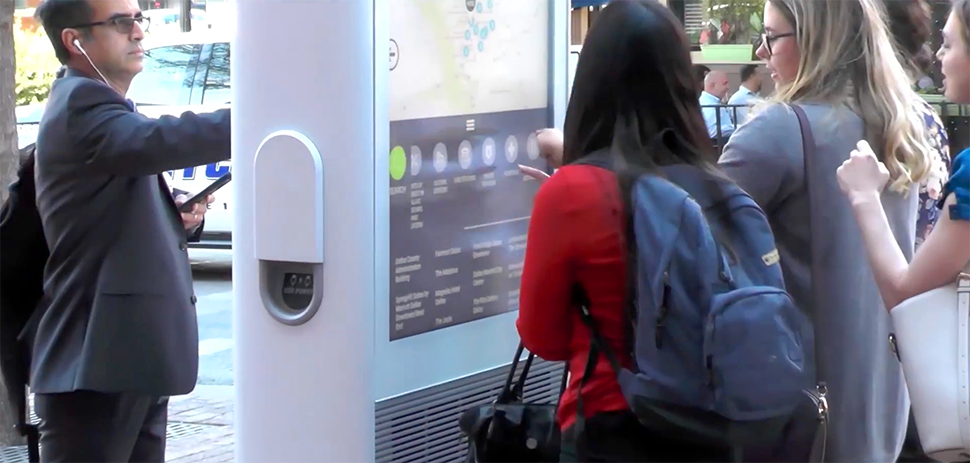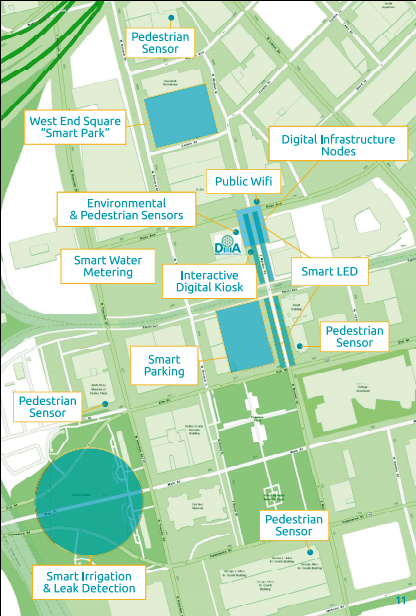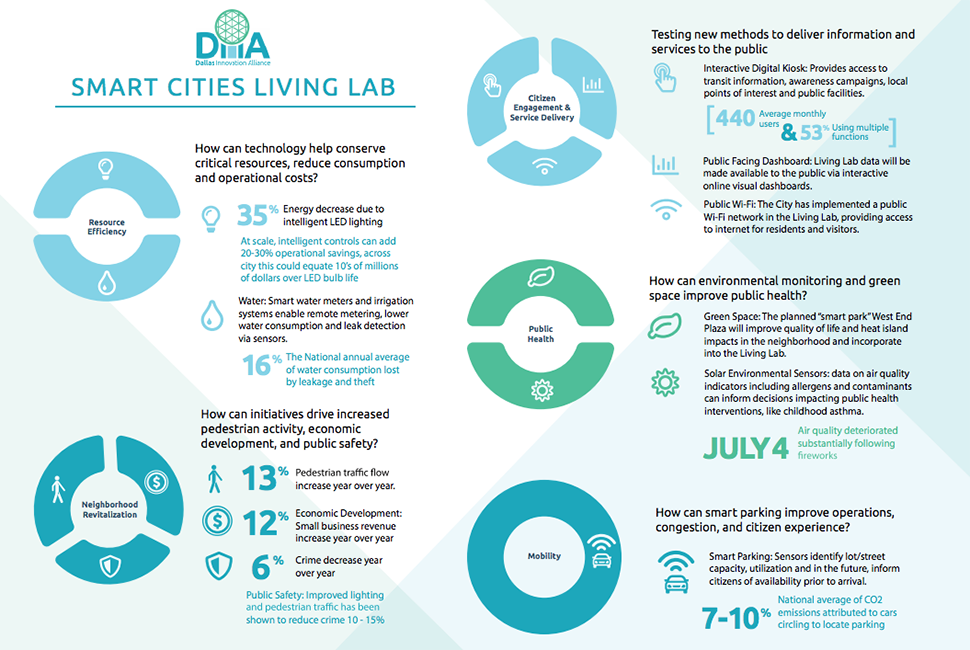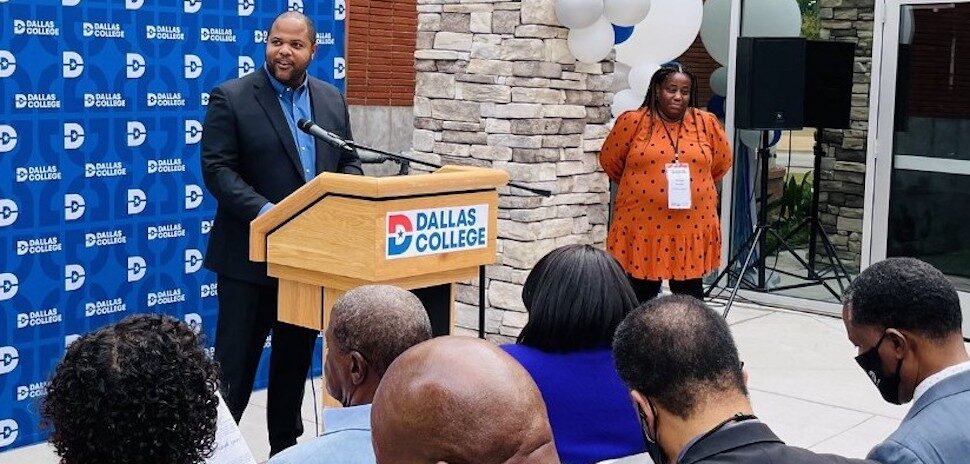The first phase of the Smart Cities Living Lab program in the West End Historic District had a positive impact on the neighborhood in downtown Dallas, according to the year-end case study released Thursday by The Dallas Innovation Alliance (DIA).
 The 36-page report from the alliance — a 501c (3) public-private partnership — is the culmination of three years of work by the organization since its launch in 2015, the city of Dallas, and 30 key regional businesses, Trey Bowles, who co-founded DIA with Jennifer Sanders, said in an email to Dallas Innovates. He said the undertaking was the fastest-to-market smart city project in the nation.
The 36-page report from the alliance — a 501c (3) public-private partnership — is the culmination of three years of work by the organization since its launch in 2015, the city of Dallas, and 30 key regional businesses, Trey Bowles, who co-founded DIA with Jennifer Sanders, said in an email to Dallas Innovates. He said the undertaking was the fastest-to-market smart city project in the nation.
Along with the report, Dallas Innovation Alliance and Amazech Solutions announced a dashboard that will make the lab’s data available to the public.
The Smart Cities Living Lab powered by AT&T launched in March 2017 in Dallas’ West End Historic District as a four-block corridor in downtown housing nine integrated smart-city projects. A partnership of organizations across public, private, civic, and academic sectors — as well as collaboration with 20 city of Dallas departments — made the Living Lab possible.
The Living Lab year-end case study offered a number of interesting insights, including:
- The West End experienced a 13 percent lift in pedestrian traffic flow during the pilot program. Local businesses saw a 12 percent increase in revenue, and crime decreased 6 percent year-over-year. Pedestrian mapping provided businesses insights on when to capture increased foot traffic.
- The smart lighting pilot led to a 35 percent energy reduction, and intelligent controls across all 85,000 lights in Dallas would equate to at least $90 million in operational savings over the life of the LED bulbs.
- Over 440 people utilized the interactive kiosk monthly on average. Fifty-three percent utilized multiple functions such as transit information, local points of interest, public facilities and a “selfie” function.
- Environmental quality sensors registered increased pollutants and particulate matter following the 4thof July fireworks, offering insights that could be used to inform the public, such as asthma sufferers, to take precautions when participating in holiday festivities.

According to the report, more than 440 people on average used the interactive kiosk monthly. Fifty-three percent utilized multiple functions such as transit information, local points of interest, public facilities and a “selfie” function. [Photo via DIA video]
The Living Lab has been described as a pilot zone and the DIA’s “phase one” smart city effort.
“The intention of becoming a smart city is to improve operations, sustainability and create an inclusive and prosperous city; testing the data and technology provides a catalyst in preparing Dallas for the future,” Dallas Mayor Mike Rawlings said in a statement. “The Dallas Innovation Alliance is a valued partner in elevating a culture of innovation in Dallas, and the insights generated by the Living Lab will be utilized as a tool to evaluate the potential of these technologies to reach our goals as a city.”
 The DIA, along with Amazech Solutions, also announced the launch of the first phase of an interactive public dashboard providing access to the Living Lab project data to students, researchers, startups, and the public. The first three projects available via the tool are intelligent lighting, the interactive digital kiosk, and environmental sensor kit.
The DIA, along with Amazech Solutions, also announced the launch of the first phase of an interactive public dashboard providing access to the Living Lab project data to students, researchers, startups, and the public. The first three projects available via the tool are intelligent lighting, the interactive digital kiosk, and environmental sensor kit.
“With the ever-increasing automation and connectedness of our world, data is abundant and can be overwhelming,” Amazech President and CEO Shanthi Rajaram said. “The ability to integrate and visualize data in an easy-to-comprehend way provides an avenue to maximize the value of data.”
The next phase for the DIA is set to begin next year and will include projects in Southern Dallas that are focused on solutions to challenges around mobility, digital divide, and public safety, among others.
The organization also is partnering with the Dallas Entrepreneur Center, AT&T Inc., Cisco, Microsoft, and the University of Texas at Dallas to launch a smart cities incubator called “Innov8te” in the West End. The program will support startups and entrepreneurs focused on solving civic challenges in eight core areas through emerging technologies and services.
AT&T’s role in the phase one Living Lab has been deploying its Digital Infrastructure nodes, smart street lights, digital kiosks, and other technologies to make the West End safer, Michael Zeto, vice president of Internet of Things at AT&T and general manager of Smart Cities, said in a statement. He said the city of Dallas is using the telecom giant’s Smart Cities framework and Internet of Things tech to “solve the problems that matter most to the community.”

![]()
Get on the list.
Dallas Innovates, every day.
Sign up to keep your eye on what’s new and next in Dallas-Fort Worth, every day.


































































